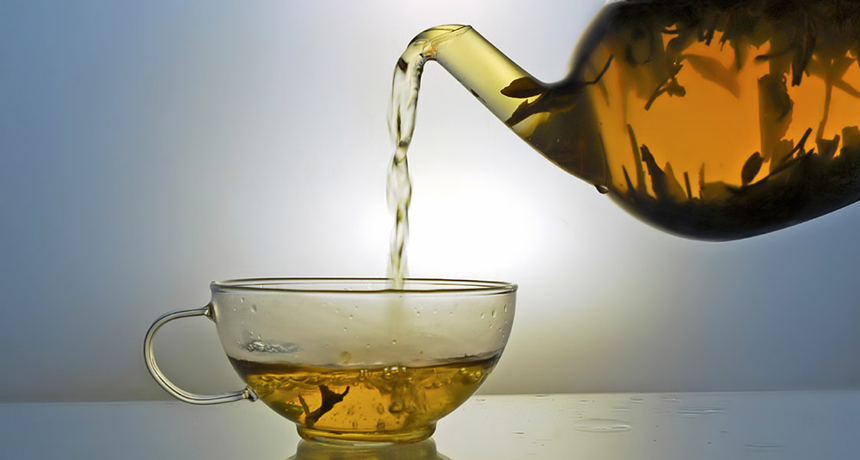Going against the flow
Tea leaves and other particles can sometimes float upstream

Tea leaves can move upstream into a teapot or kettle, a new study reports. Scientists say the phenomenon is caused by a difference in surface tension between the water in the kettle and the water in the cup.
ISTOCKPHOTO
When water flows, anything in it moves too. But not necessarily in the same direction. Sometimes particles can head upstream, scientists now report. In a paper published July 3, they show how tiny tea leaves seemingly defy gravity to move against the flow.
“It’s interesting and very cool,” Eva Kanso told Science News. Kanso, a physicist at the University of Southern California, San Diego, did not work on the study. Indeed, she noted: “I’m going to have my students do an experiment like this.”
The story behind the new study began in 2008. At the time, Sebastian Bianchini was a student at the University of Havana in Cuba. After pouring hot water into a cup containing tea leaves, one day, he noticed that a few tea leaves had entered the kettle.
But that didn’t make sense: Water flowed from the kettle to the cup, not the other way around. So how could the leaves have traveled up the water and into the spout?
Puzzled, the young scientist performed the curious teacup experiment for Ernesto Altshuler, a physicist at the university. (Physicists study the properties of energy and matter.) The pair ran a few more tests of the phenomenon to confirm it was real. Then they looked for an explanation. Other scientists were so skeptical of the strange data that Altshuler and Bianchini did not initially publish their results.
But last year, Altshuler told another physicist, Troy Shinbrot, about the experiment. Shinbrot, at Rutgers University in Piscataway, N.J., decided to run the experiment for himself. He set up two water tanks, one slightly above the other. Water flowed from the upper tank to the lower one through a small channel. As it did, Shinbrot sprinkled tea leaves and ground-up chalk into the lower tank. Within seconds, tiny bits of chalk and tea leaves climbed the channel. He found them settling into the upper tank.
Bianchini — along with Altshuler and Shinbrot’s group — has just published these confirmatory data. They argue that the effect is due to a physical property called surface tension. In a liquid like water, molecules stick to those around them. But molecules at the surface don’t have as many neighbors as do those underneath. So surface molecules form tighter bonds with the few neighbors that are around. Together, they form an elastic layer. It’s almost like a trampoline. Because of surface tension, a paper clip or needle can float if laid gently onto the water’s surface. But if that object breaks the surface, it pushes apart those supporting molecules — and sinks.
The floating tea-leaf and chalk particles lessened the surface tension in the lower tank. Meanwhile, surface tension in the upper tank remained high.
Scientists have known since the 19th century that when the surface tension of two liquids differs, their molecules will push and pull on each other until they balance out. In the tea-leaf experiment, the lower tank’s reduced surface tension caused water molecules in that tank to push the tiny particles up the water channel and into the upper tank. This helped balance out the surface-tension difference between the two tanks.
Even though scientists knew about this force, they didn’t realize it was strong enough to transport something as large as tea leaves.
Shinbrot acknowledges that his tea-leaf data are quirky. But they may also have real world consequences, he told Science News: Scientists will want to know, for example, if particles of pollution might similarly float up a slowly moving river.
Power Words
molecule A group of atoms bonded together. The molecules that make up water include two atoms of hydrogen and one atom of oxygen.
atom The basic unit of a chemical element.
surface tension The tension of the surface film of a liquid caused by the strong bonds between the molecules in the surface layer.
physics The scientific study of the nature and properties of matter and energy.
particle A minute amount of something.







